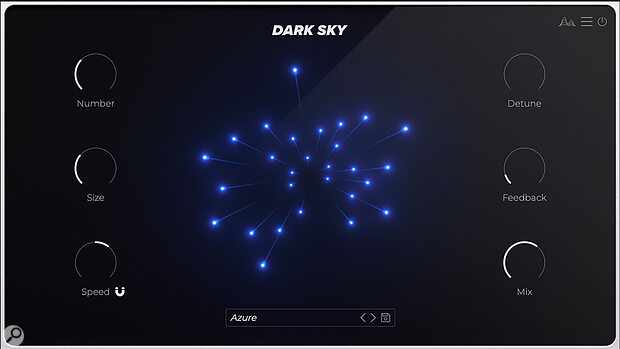Supporting the common 64‑bit macOS and Windows plug‑in platforms (VST3, AU and AAX), Cymatics’ Dark Sky was inspired by Hologram’s impressive but rather costly Microcosm pedal (reviewed in SOS September 2022). Pedals invariably have fewer user‑adjustable parameters than typical plug‑ins, but more controls can also mean greater complexity for the user. Cymatics, then, opted to adhere to a pedal‑like philosophy, providing just six controls in this plug‑in, one of which is the familiar wet/dry Mix control. Despite this apparent simplicity, though, Dark Sky is capable of creating a usefully wide range of engaging, shimmery textures and grainy backdrops.
The Number parameter determines how many grains (short snippets of sound) are extracted from the audio buffer. The greater the number of grains, the smoother and denser the result. Because granular effects of this type are essentially delay‑based, what you hear at the output is smeared in time, and this lends a delay‑meets‑reverb quality to the sound. Size sets the length of the grains, and at shorter settings, especially combined with a low number of grains, the effect becomes more ‘chattery’, while at longer settings it’s smoother and more dense. Speed is an important control, as this sets the playback speed — and therefore the pitch — of the grains, with a range of ±2 octaves. In positions that are anti‑clockwise from centre, the grains are reversed. Naturally, the most musical‑sounding settings are octaves, but you can explore all the in‑between settings if you like, either in coarse, logical steps or, if you click on the magnet icon to change that, continuously. An animated starburst at the centre of the GUI gives some indication of the movement and density of the grains.
Detune adds random but small pitch changes to the individual grains, creating a more dense, ensemble kind of sound, while Feedback sends the grains back into the input, in much the same way as the feedback control on a conventional delay. Set this parameter to maximum, and the pedal will produce a continuous output. Because of the simplicity of the controls, it’s rather difficult to get an unpleasant result, but setting odd Speed values might get you some way towards a ‘haunted house’ vibe if that’s what you need.
With some source sounds the effect itself can even take on a slightly vocal quality.
Rich And Glittery Character
Sonically, Dark Sky has an endearingly rich and glittery character, one that can liven up the most bland synth sound or the driest guitar or piano part. It can also produce interesting results on drums, and even vocals. With octave‑up settings, the sound is like a more textural alternative to a shimmer reverb, and with some source sounds the effect itself can even take on a slightly vocal quality. With reversed Speed settings, on the other hand, some outcomes can be more reminiscent of bowed strings.
There’s a generous range of presets to explore, and they might help you understand the controls better, but the real beauty of this plug‑in is how easy it is to create your own effects. I would perhaps have liked just one more control — to add octave up and down pitch‑shift to randomly chosen grains — but other than that it ticks a lot of boxes. If you want to add some granular fairy dust but without making your brain or wallet hurt, Dark Sky is most definitely worth checking out.

